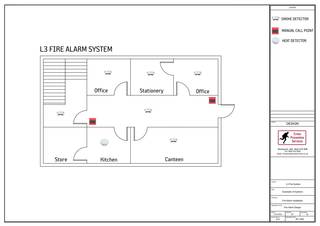Fire Alarms
Fire Alarm Categories for Your Business
We provide a range of fire alarm systems for commercial premises. Depending on your business requirements, systems can differ greatly. We have outlined the four life-saving systems below. Each caters to a different environment and prices can fluctuate depending on the needs of smaller commercial customers or buildings of multiple occupancy.
The recent update to BS 5839‑6 has brought about significant changes to its grading system, which classifies the level of protection required for different properties based on their risk factors. The previous system consisted of six grades, but it has now been modified. Grade B and Grade E have been eliminated, while Grade D and Grade F have been subdivided into Grade D1 / Grade D2 and Grade F1 / Grade F2, respectively. Grade C has undergone revisions, resulting in an expansion of its recommendations.
The revised grading system is as follows:
Grade A: This grade entails separate detectors, sounders, and central control and indicating equipment, all equipped with a backup power supply conforming to British Standards BS EN 54.
Grade C: Grade C involves separate detectors and sounders that are mains powered with backup power supply and central control equipment.
Grade D1: This grade encompasses a system of one or more mains powered detectors, each equipped with a tamper‑proof standby supply consisting of a battery or batteries.
Grade D2: Grade D2 consists of a system of one or more mains-powered detectors, each featuring an integral standby supply consisting of a user‑replaceable battery or batteries.
Grade F1: This grade comprises a system of one or more battery-powered detectors powered by a tamper‑proof primary battery or batteries.
Grade F2: Grade F2 entails a system of one or more battery-powered detectors powered by a user‑replaceable primary battery or batteries.
When designing, constructing, and managing fire detection and fire alarm systems in residential properties, we adhere to the above-mentioned grades. It is also crucial to stay informed about the revisions made to Table 1 of The Standard, which specifies the minimum grade and category of system required to ensure life protection in typical premises. These updates have been made to align with current living conditions.
In terms of categories for fire detection and fire alarm systems, there has been an elevation in the standard of protection for sheltered housing flats from Category LD2 to Category LD1, indicating a higher potential risk. To meet LD1 requirements, a fire detection system must be installed throughout the premises, covering all rooms (including circulation areas forming part of escape routes) except for toilets, bathrooms, and shower rooms.
The three categories for fire detection and fire alarm systems are detailed below, specifying where fire detection systems should be installed:
LD1 Maximum Protection:
This category provides the highest level of protection for all occupants who may reside in the dwelling during the lifetime of the fire detection and fire alarm system. It necessitates the installation of detectors in all circulation areas forming part of the escape routes from the premises, as well as in all rooms and areas, except those with minimal sources of ignition, such as toilets, bathrooms, and shower rooms.
LD2 Additional Protection:
Category LD2 involves a system that includes detectors in all circulation areas forming part of the escape routes from the premises, as well as in specified rooms or areas presenting a high fire risk to occupants, including any kitchen and the principal habitable room.
LD3 Minimum Protection:
Category LD3 mandates a system with detectors exclusively in circulation areas forming part of the escape routes from the premises.
Note: The minimum LD3 category now applies only to owner-occupied bungalows, flats, single-storey units, or maisonettes with no floor level above 4.5 meters from ground level or owner-occupied two-storey houses.
Fire Alarm Categories for Your Business
We provide a range of fire alarm systems for commercial premises. Depending on your business requirements, systems can differ greatly. We have outlined the four life-saving systems below. Each caters to a different environment and prices can fluctuate depending on the needs of smaller commercial customers or buildings of multiple occupancy.

L1 Fire Alarm System
An L1 fire alarm system provides the highest standard for the protection of life. Fire alarm detectors are installed in all rooms and areas of the building, including roof spaces and voids. Some areas need not be protected if they are of low fire risk such as stairways, lobbies and small cupboards. Typical installations for an L1 system include residential care premises and large office blocks.

L2 Fire Alarm System
An L2 fire alarm system is designed to give an early warning of fire to occupants beyond the room in which the fire starts and to provide early detection in areas of high risk. It is our job as fire alarm designers to look at your building plan and recommend extra detection for high risk areas. Example areas of high risk could include boiler rooms, plant rooms and other areas with heavy plant machinery.

L3 Fire Alarm System
L3 fire alarm systems incorporate manual call points (MCPs) at defined positions and automatic fire detection (AFD) in all escape routes, rooms, corridors, and compartments that open onto escape routes.

L4 Fire Alarm System
An L4 fire alarm system provides automatic fire detection within escape routes comprising circulation areas and spaces, such as corridors and stairways. An L4 system would not satisfy the requirements of legislation in buildings in which people sleep.

L5 Fire Alarm System
Often the requirement for an L5 fire alarm system is based on recommendations from a fire risk assessment. This is a custom category and relates to special client requirements for their premises. The details need to be specified by a qualified fire engineer. For example, this could be a fire extinguishing system triggered by automatic detection.

